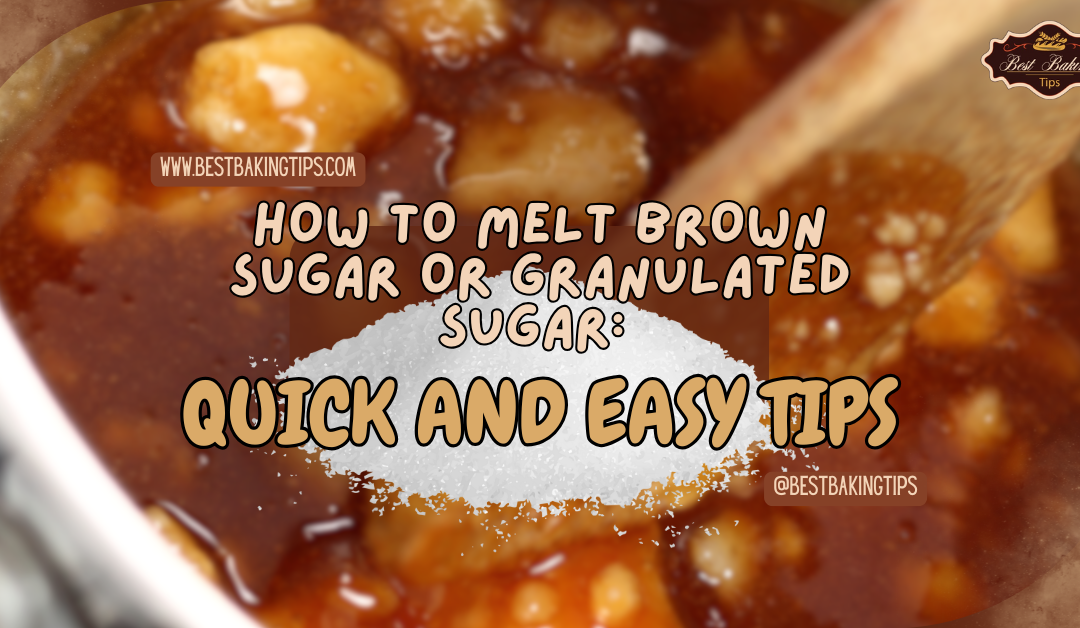==================
Affiliate Statement
Best Baking Tips is supported by our audience. When you purchase through one of our links, we may earn a small affiliate commission. As an Amazon Associate I earn from qualifying purchases. Your cost is not affected.
==================
Looking to make a luscious, smooth syrup for your favorite desserts? Whether you’re creating caramel, drizzling over ice cream, or sweetening up a sauce, melting sugar into syrup is a simple skill that goes a long way in the kitchen. With a few easy techniques, you can turn plain sugar into a rich, glossy syrup that adds a touch of sweetness to just about anything. Let’s dive into some quick, foolproof methods to melt sugar perfectly every time, no fancy equipment is required!
How to Melt Brown Sugar or Granulated Sugar: Quick and Easy Tips for Home Bakers
Melting sugar might seem tricky, but it’s a skill you can easily master. Whether you’re working with brown sugar or granulated sugar, the process is simple. To melt sugar, heat it gently in a dry pan or with a small amount of water until it turns into a liquid syrup.
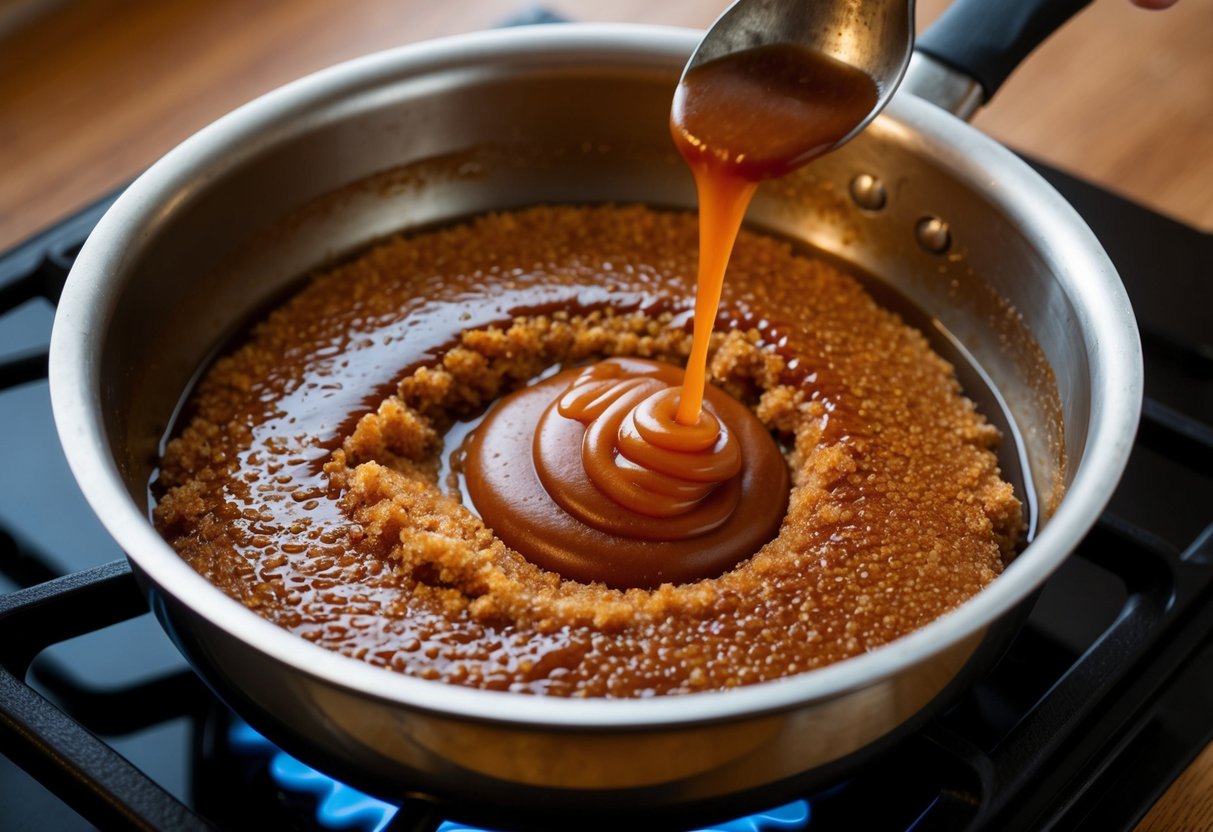
Brown sugar needs a bit more care due to its moisture content. You can melt brown sugar in the microwave by placing it in a bowl with some water nearby. This keeps it moist and prevents burning. For granulated sugar, you can melt it directly in a pan or add a splash of water to help it along.
Knowing how to melt sugar opens up a world of sweet treats. You can make caramel, syrups, and glazes for all sorts of desserts. With a little practice, you’ll be melting sugar like a pro in no time.
Key Takeaways
- Heat sugar gently to melt it into a liquid syrup
- Brown sugar needs moisture to melt evenly
- Melted sugar can be used for various sweet treats
Understanding Sugar Types

Sugar comes in different forms, each with unique properties. Knowing the types helps you choose the right one for melting and other uses in recipes.
Brown Sugar: Flavor and Moisture
Brown sugar adds a rich taste to foods. It’s made by mixing white sugar with molasses. There are two main types:
- Light brown sugar: Less molasses, milder flavor
- Dark brown sugar: More molasses, stronger flavor
Brown sugar has more moisture than white sugar. This affects how it melts. When melting brown sugar, you need to add extra water to prevent scorching. The moisture in brown sugar can make it clump. To soften hard brown sugar, try putting it in a microwave with a damp paper towel for a few seconds.

Granulated Sugar and Its Forms
Granulated sugar is the most common type. It’s white and has medium-sized crystals. This sugar melts easily and is great for many recipes.
Other forms of granulated sugar include:
- Powdered sugar: Very fine, mixed with cornstarch
- Superfine sugar: Smaller crystals, dissolve quickly
- Coarse sugar: Larger crystals, good for decorating
When melting granulated sugar, you can use the dry or wet method. The dry method involves heating sugar alone, while the wet method adds water. Granulated sugar melts at a higher temperature than brown sugar. Be careful not to burn it when melting.
Preparation Basics
Getting ready to melt sugar is easy with the right tools and know-how. You’ll want to focus on picking the best equipment and keeping an eye on temperature.
Choosing the Right Tools
To melt sugar safely, you’ll need some key items. A heavy-bottomed saucepan is perfect. It spreads heat evenly and prevents burning. A heat-resistant spatula is great for stirring. It won’t melt or warp in the hot sugar. Don’t forget a candy thermometer! It helps you track the sugar’s temperature as it melts. For easy cleanup, try a non-stick pan. Sugar can be sticky, so this makes your job simpler.
Importance of Temperature Control
Keeping the right temperature is crucial when melting sugar. Too hot, and it burns. Too cool, and it won’t melt properly. White sugar starts to melt at 320°F. Brown sugar melts a bit lower, around 300°F.
Use low to medium heat when you start. This lets the sugar melt slowly and evenly. Watch the color change. As sugar melts, it turns golden, then amber. This tells you it’s ready. Your candy thermometer is your best friend here. It helps you avoid overheating and burning.
Melting Sugar: Methods and Techniques

Sugar melting is a key skill in making treats and sauces. There are several ways to turn solid sugar into liquid form. Each method has its own steps and uses.
Dry Method for Melting Sugar
The dry method for melting sugar is a straightforward way to turn granulated sugar into a smooth, amber-colored liquid without any water. Here’s how it works:
Wet Method for Sugar Syrup
Microwave Method
Microwaving is a fast and convenient way to melt sugar. Here’s how to do it safely:
- Prepare Your Ingredients: Place sugar in a microwave-safe bowl, adding just a splash of water or lemon juice to help it dissolve smoothly.
- Microwave in Short Bursts: Heat the sugar mixture in 30-second intervals, stirring in between each burst. This prevents uneven melting and reduces the risk of burning.
- Monitor Closely: Continue heating and stirring until the sugar has fully melted. Keep a close watch—sugar can heat up quickly in the microwave and may caramelize faster than expected.
- Handle with Caution: When the sugar has melted, carefully remove the bowl, as both the sugar and the bowl will be extremely hot. Use oven mitts or a thick towel to protect your hands.
This method is great for quick melting, but it does require careful attention since sugar heats up fast in the microwave.
Double Boiler Method
Stovetop Method
The stovetop method is a classic and versatile way to melt sugar, allowing you to control the texture and color for different recipes. Here’s how to do it effectively:
- Choose a Heavy-Bottomed Pan: Use a heavy pan to ensure even heat distribution and prevent hot spots, which can cause the sugar to burn. Set the heat to medium.
- Select Your Method: You can use either the dry or wet method here:
- Dry Method: Simply add sugar directly to the pan.
- Wet Method: Combine sugar with a small amount of water (about 1/4 cup per cup of sugar) to help it dissolve more gradually.
- Stir Regularly: Use a wooden spoon or heatproof silicone spatula to stir the sugar, especially at the beginning. This helps ensure even melting.
- Watch the Color Transformation: As the sugar melts, it will change from white crystals to a golden liquid and then to a rich amber. Stop at your desired stage—light gold for a mild flavor, or deep amber for a bolder, caramelized taste.
The stovetop method is ideal for making syrups, caramel, and candies, as you can easily control the sugar’s consistency and flavor by adjusting the heat and cooking time.
Oven Method
The oven method for melting sugar is a slower, hands-off approach, perfect when you’re multitasking in the kitchen. Here’s how to do it:
- Prepare Your Sugar: Place sugar in an oven-safe dish or baking pan, spreading it in an even layer for consistent melting.
- Set the Oven Temperature: Preheat your oven to 350°F (175°C).
- Bake and Stir Periodically: Place the dish in the oven, and check on the sugar every 15 minutes, giving it a quick stir each time. This ensures it melts evenly without clumping.
The oven method takes longer than stovetop melting but is low-maintenance and allows the sugar to melt gradually. It’s ideal when you want even melting with minimal supervision, making it perfect for multitasking chefs.
Cooking with Melted Sugar
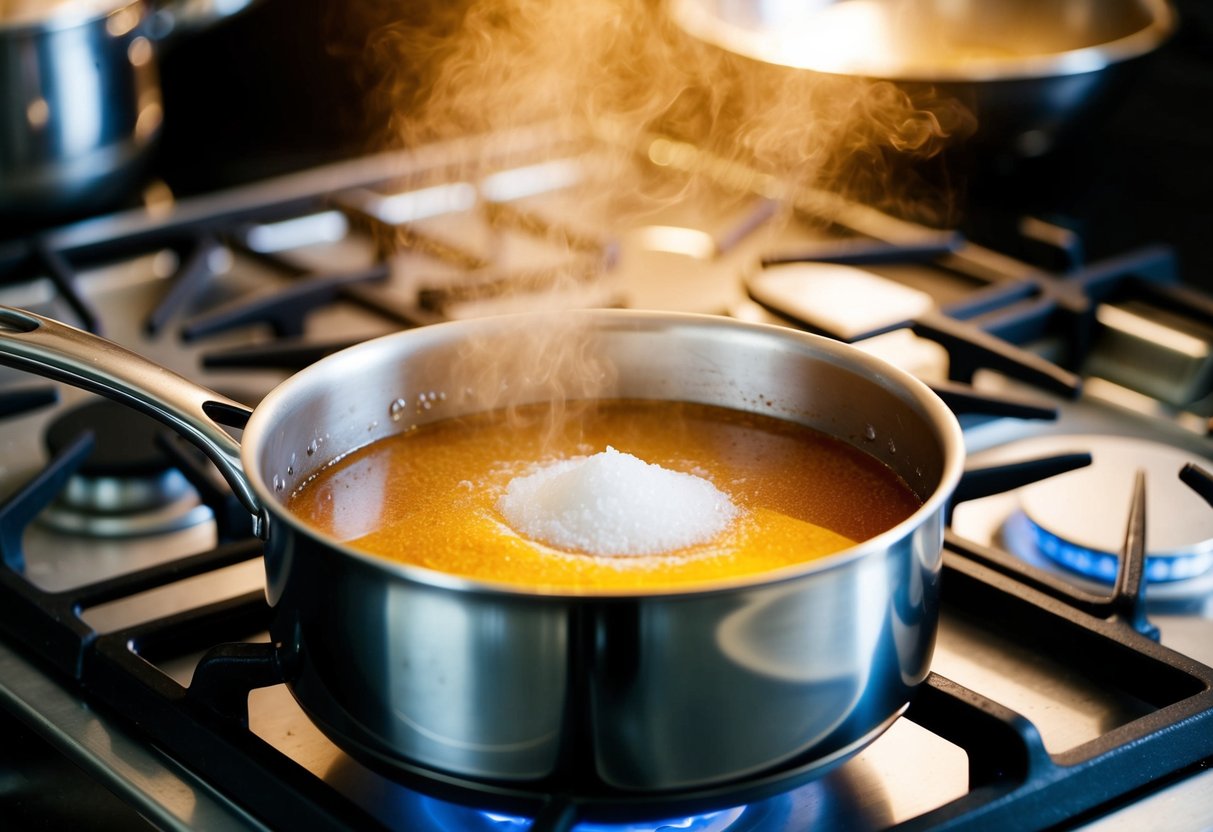
Melted sugar opens up a world of culinary possibilities. You can use it to create sweet treats, enhance flavors, and add beautiful finishes to your dishes.
Caramel and Caramelization
When you heat sugar, it turns into caramel. This process, called caramelization, gives a rich, nutty flavor to your dishes. You can make caramel sauce by melting sugar in a pan over medium heat. Stir it constantly to avoid burning.
Once the sugar melts and turns golden brown, remove it from the heat. Add cream or butter for a smooth texture. You can use this sauce on ice cream, cakes, or even in savory dishes. Caramelized sugar also adds depth to meat dishes. Try sprinkling some on roasted vegetables for a sweet crunch.

Sugary Glazes and Toppings
Melted sugar makes great glazes for baked goods. You can create a simple sugar glaze by mixing melted sugar with a little milk or water. Pour this over cakes, cookies, or pastries for a sweet, shiny finish. For fruit tarts, try brushing melted sugar directly onto the fruit. It will harden into a glossy coating, making your dessert look extra fancy.
You can also use melted sugar to make brittle toppings. Pour thin layers of melted sugar onto parchment paper and let it cool. Break it into pieces for a crunchy garnish on desserts.
Baking with Melted Sugars
Melting brown sugar can enhance your baked goods. It gives a deeper flavor to cookies and cakes. Try melting the sugar before adding it to your batter. For chewy cookies, melt the sugar with butter before mixing in other ingredients. This creates a denser texture.
In fruit pies, pour a little melted sugar over the filling before baking. It will create a sweet, crispy top layer. For a twist on traditional recipes, try substituting some of the regular sugar with melted sugar. It can add interesting flavors and textures to your baked treats.
Candies and Confectioneries
Making candy requires precise sugar melting. You’ll need a candy thermometer to get the right temperature. Different temperatures create different textures:
- Soft Ball (235-240°F): For fudge and pralines
- Hard Ball (250-265°F): For marshmallows and nougat
- Soft Crack (270-290°F): For toffee and butterscotch
- Hard Crack (300-310°F): For lollipops and hard candies
To make caramel candies, heat sugar until it’s golden brown. Add cream and butter, then pour into molds. Let it cool for chewy, sweet treats. Remember to be careful when working with hot sugar. It can cause serious burns if it touches your skin.
Achieving the Perfect Consistency
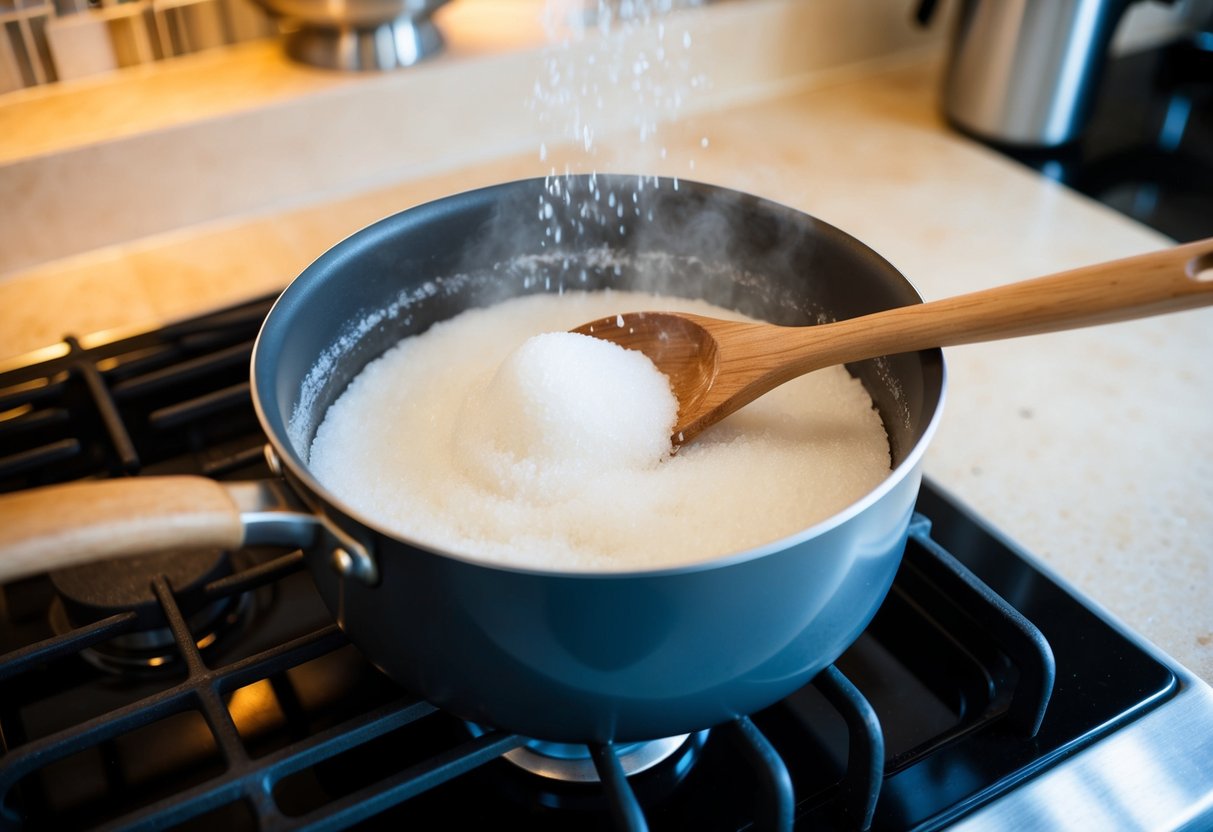
Getting the right consistency when melting sugar is key for many recipes. You’ll need to pay attention to temperature and timing to avoid problems.
Preventing Crystallization
To keep your melted sugar smooth, be careful not to let it crystallize. Start with a clean pot and don’t stir once the sugar starts boiling. Brushing the sides of the pot with water can help. If you see crystals forming, don’t panic! Add a little corn syrup or lemon juice. This prevents more crystals from growing.
For brown sugar, the process is a bit different. You’ll want to stir it constantly over medium heat until it melts. Keep a close eye on it to avoid burning.
Creating Spun Sugar and Sugar Decorations
Spun sugar adds a fancy touch to desserts. To make it, you’ll need to heat your sugar to the hard-crack stage (300°F-310°F). Be extra careful – it’s super hot! Once ready, use a whisk or fork to fling thin streams of sugar onto parchment paper. Work fast before it cools.
For sugar cages, drizzle the hot sugar over an upside-down bowl. Let it cool, then gently remove it. These decorations are delicate, so handle them with care. Tip: Make extras in case some break!
Thread Stage in Candy Making
The thread stage is important in candy making. It happens when the sugar syrup reaches 230°F-235°F. At this point, the syrup forms thin threads when dropped from a spoon.
To test, dip a spoon in the syrup and lift it. Let it cool a bit, then touch it with your thumb and forefinger. As you pull them apart, you’ll see a thin thread. This stage is perfect for making syrups and some types of fudge. Keep a close eye on your thermometer to hit this sweet spot!
Troubleshooting Common Issues
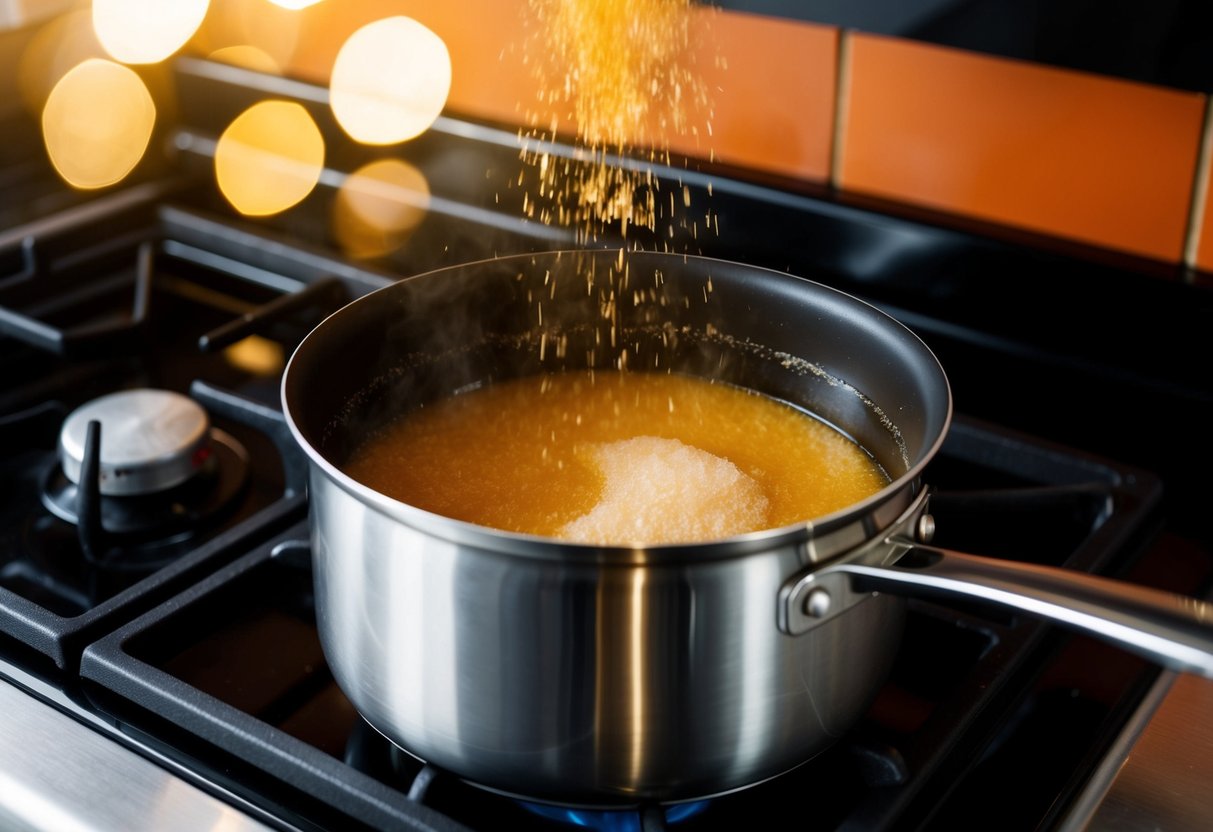
Melting sugar can sometimes be tricky. Let’s look at how to fix burnt sugar and soften hardened sugar so you can get your recipes back on track.
Addressing Burnt Sugar
Oops! Did your sugar turn dark and smell smoky? Don’t worry, it happens to the best of us. To avoid burning sugar, use low heat and stir often. If it does burn, start over with fresh sugar.
Here’s what to do:
- Remove the pan from heat right away
- Let it cool slightly
- Carefully pour out the burnt sugar
- Soak the pan in hot water to clean
For caramelized sugar, watch it closely. It can go from golden to burnt in seconds. Use a candy thermometer to keep the temp steady.
Dealing with Hardened Sugar
Sugar can turn into hard lumps, making it tough to melt. But you can fix this! Try these tips to soften your sugar:
- Put the sugar in a bowl with a damp paper towel. Cover and wait a few hours.
- Microwave the sugar in 15-second bursts, stirring between each.
- Add a slice of bread to the container. The moisture will help soften the sugar.
To prevent crystallization, don’t stir the sugar while it’s melting. Just swirl the pan gently. If crystals form, brush the sides of the pan with water using a pastry brush.
Alternative Sweeteners and Melting Techniques

Different sweeteners have unique melting properties. Knowing how to work with them can help you create tasty treats.
Using Alternative Sweeteners
Using alternative sweeteners can add unique flavors and benefits to your recipes. Here’s how to substitute some common options:
- Coconut Sugar: This is a great alternative to brown sugar, with a natural toffee-like flavor. It melts similarly to brown sugar, making it an easy swap in most recipes. Just use it in a 1:1 ratio.
- Honey: Since honey is already liquid, you don’t need to melt it—just warm it slightly if you’d like it thinner for mixing. Honey brings a natural sweetness with subtle floral notes, making it ideal for baked goods, dressings, and sauces.
- Maple Syrup: Like honey, maple syrup is liquid and doesn’t require melting. It adds a deep, earthy sweetness to recipes. Swap it in for liquid sweeteners in a 1:1 ratio, and slightly reduce other liquids to balance the consistency.
- Agave Nectar: Agave is sweeter than regular sugar, so you’ll need less of it—try using about 2/3 of the sugar amount in your recipe. It’s great for adding mild sweetness without overpowering flavors.
- Stevia: Stevia is extremely sweet, so a little goes a long way. Be cautious with the amount, as it doesn’t caramelize or provide bulk like sugar, making it unsuitable for recipes that rely on sugar for texture or browning.
Experimenting with these alternatives can bring new flavors and textures to your cooking while allowing you to adjust sweetness levels and try different health benefits.

Adjusting Techniques for Different Sweeteners
When using alternative sweeteners, you might need to change your approach. For coconut sugar, melt it like brown sugar. Use low heat and stir often to prevent burning. With liquid sweeteners like honey or maple syrup, you may need to reduce other liquids in your recipe. If you’re using stevia, add it at the end of cooking. It doesn’t need heat to dissolve.
When baking with alternative sweeteners, watch your cooking times. They can brown faster than regular sugar. Remember, these sweeteners may change the texture of your final product. Be prepared to experiment a bit!
Fun Fact
Did you know why brown sugar melts differently? Brown sugar contains molasses, which adds extra moisture and gives it a unique texture. This moisture helps prevent it from hardening as quickly as granulated sugar when melted. The molasses also imparts a deeper, richer flavor to the syrup, often described as toffee-like, making it perfect for creating more flavorful, velvety sauces and caramelized treats.
Melting Sugar Made Easy
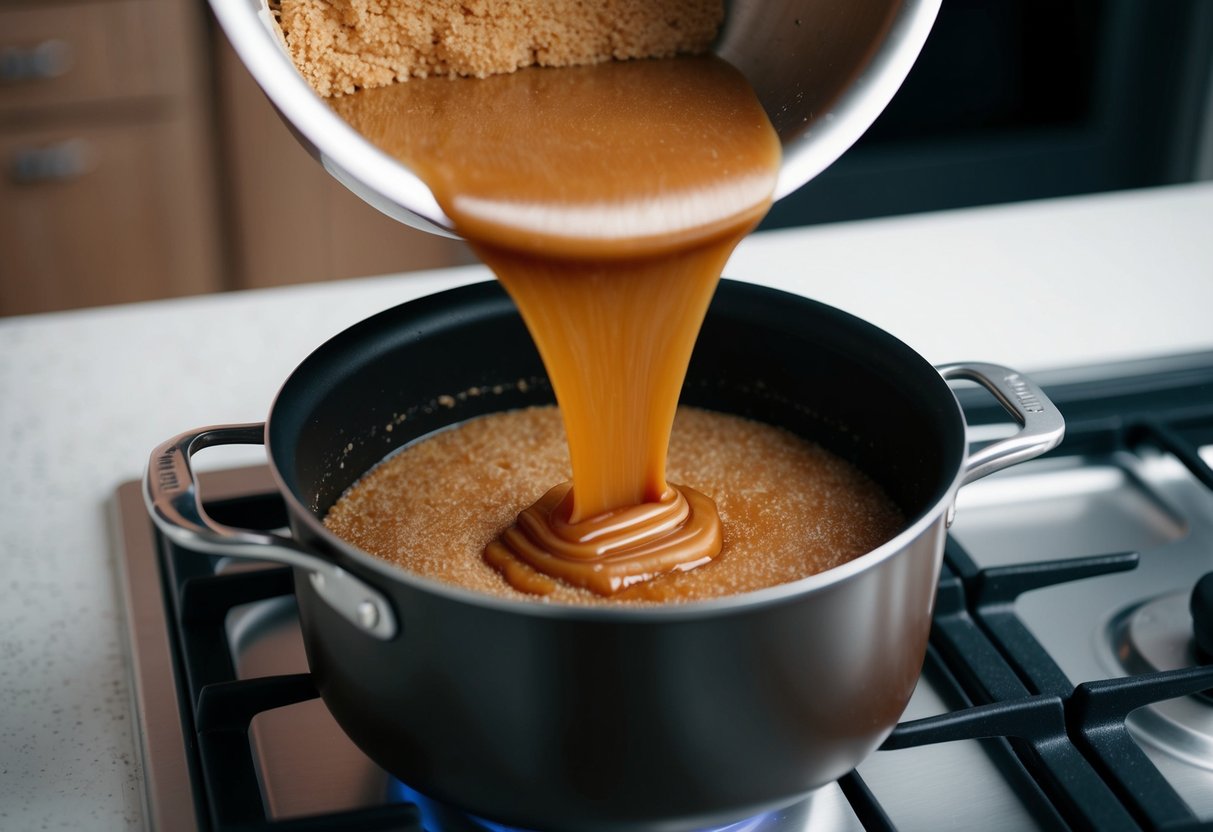
Melting sugar is simpler than it might seem, and with just a few easy steps, you can turn granulated or brown sugar into a smooth, delicious syrup for all kinds of treats. The key is patience—use low to medium heat and avoid rushing, as high heat can quickly lead to burning. If you’re working with brown sugar, adding a bit of water keeps it moist and prevents it from drying out or hardening.
To get the best results, use a heavy-bottomed pan, heat the sugar gradually, and stir gently to prevent crystals from forming. Watching closely as it melts will help you achieve a beautiful, even caramelization. With a bit of practice, you’ll master the art of melting sugar and soon be whipping up caramel sauces, candies, and other sweet creations effortlessly. Happy cooking, and enjoy crafting your sugary delights!
Ready to create delicious treats with melted sugar? Share your tips and tricks for melting sugar to syrup form. Let’s inspire each other to explore the world of sugar artistry!
Frequently Asked Questions

Melting sugar can be tricky. Here are answers to common questions about melting brown and white sugar using different methods and for various purposes.
What's the best way to melt brown sugar in a pan?
To melt brown sugar in a pan, use low to medium heat. Put the sugar in a dry, non-stick pan. Stir it often with a wooden spoon or heat-safe spatula. Keep stirring until the sugar turns into a golden-brown liquid. Watch it closely to avoid burning. Take the pan off the heat as soon as the sugar is fully melted.
Can you melt granulated sugar in the microwave, and if so, how?
Yes, you can melt granulated sugar in the microwave. Put the sugar in a microwave-safe bowl. Heat it in 30-second bursts, stirring between each burst. Keep heating and stirring until the sugar melts. Be careful, as the melted sugar will be very hot.
How can I melt brown sugar into syrup?
To make brown sugar syrup, mix equal parts brown sugar and water in a pot. Heat the mixture on low, stirring until the sugar dissolves. Then, increase the heat to medium-high and let it boil. Stir occasionally until the syrup thickens to your liking. Let it cool before using.
Is it possible to melt sugar without adding water?
Yes, you can melt sugar without water. This is called dry melting. Put sugar in a clean, dry pan over medium-low heat. Don’t stir at first, just let the sugar heat up. As it starts to melt, gently push the solid sugar into the liquid parts. Be patient and careful not to burn it.
What technique should be used to melt brown sugar in butter?
To melt brown sugar in butter, start by melting the butter in a pan over low heat. Once it’s melted, add the brown sugar. Stir the mixture constantly. Keep stirring until the sugar dissolves into the butter. This creates a sweet, buttery sauce perfect for many recipes.
Does granulated sugar caramelize the same way as brown sugar?
Granulated sugar and brown sugar caramelize differently. White sugar melts into a clear liquid before turning golden. It has a purely sweet taste. Brown sugar already has a caramel flavor. It melts faster and turns darker quicker. The molasses in brown sugar gives it a richer taste when caramelized.
Learn The Best Baking Tips!
Are you ready to unlock your full baking potential? Whether you’re a seasoned pro or just starting your culinary journey, there’s always something new to discover. Let’s bake together! Follow us on:
Join us on this exciting journey and discover something new with every bake!

